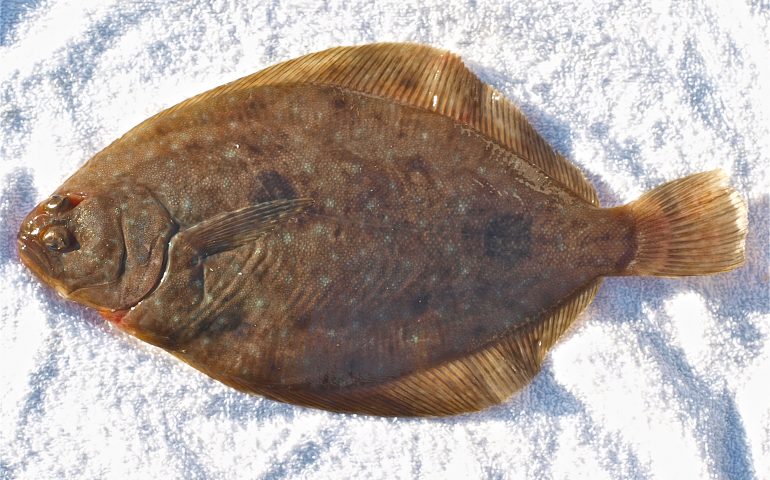Lefteye Flounders: Family Bothidae
Species: Xystreurys liolepis (Jordan & Gilbert, 1880); from the Greek words Xystreurys (meaning raker and wide), and liolepis (smooth and scale).
Alternate Names: Long fin sole, long finned flounder, fantail halibut, fantail flounder, true petrale.
Identification: Oval-shaped with a highly arched lateral line. The mouth is small and the pectoral fin is longer than the head. Uniform brown or tannish above with blue spots and generally two larger and darker spots (ocelli), one located near the pectoral fin and the other farther back.
Size: Length to 25 inches. The California record fish weighed 8 lb 8 oz and was taken at San Clemente Island in 2001. The listed IGFA World Record fish weighed 8 Lbs 12 oz and was taken at San Clemente Island in 2001.
Range: Gulf of California, and along the Pacific Coast, Isla Creciente (near Bahía Magdalena), southern Baja California, Bahía de Sebástian Vizcaíno, central Baja California, north to Monterey Bay, central California. Common from Gulf of California, to southern California.
Habitat: From the surf zone down to to 446 feet but typically in water 20-164 feet deep. Generally found on sandy spots among eelgrass beds, kelp or rocks. Favorite foods include small shrimp, crab and squid.
Piers: More common to deeper water, fantails are an infrequent catch at piers; primarily taken at piers from Santa Barbara south. I have only taken four from piers—Huntington Beach Pier (1994), Malibu Pier (2014), Gaviota Pier (2008), and Pismo Beach Pier (1977).
Shoreline: Rarely caught from shore.
Boats: An occasional catch from boats.
Bait and Tackle: Most often caught on fairly small hooks (size 4 or 2) and a variety of baits including strip bait (squid and fish) and sea worms.
Food Value: Good. The flesh is white colored, mild flavored, soft in texture, and low in fat content. It is suitable for any method of cooking.
Comments: Primarily taken by recreational fishermen and fisherladies; there’s no commercial fishery for fantails.
